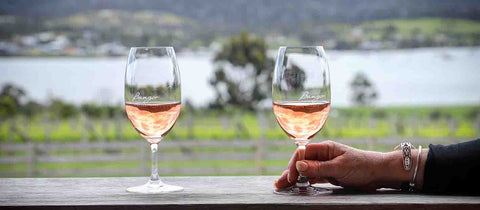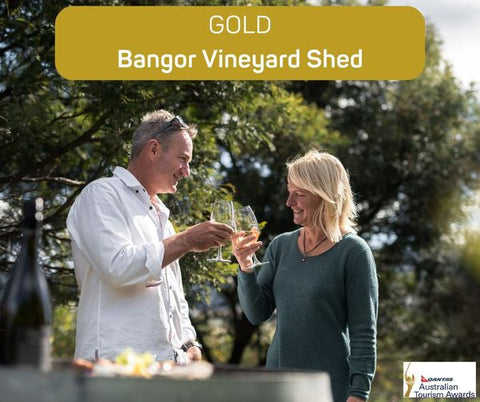Tasmanian Rosé: An Island's Gift to Wine Lovers
A small island off Australia's south coast, we like to think of ourselves as a hidden gem here in Tasmania. Not only will you find the world’s cleanest air and water, remote isolated beaches, rugged headlands, and world-heritage bushwalking that is second to none, you’ll also be blown away by our exceptional cool-climate wines.
Known for our Pinot Noir, Tasmanian Pinot Noir Rosé is a stand-out wine. Testament to our island's unique terroir and the meticulous craftsmanship of our vintners, there is no doubt that Tasmanian Rosé deserves a spot in your wine collection.
The Origin and Process
Rosé wine, often associated with the sun-drenched vineyards of Provence, France, has a rich history dating back to ancient times. Unlike red wine, rosé is made from red grapes where the skins are allowed to remain in contact with the juice for a short period, typically a few hours to three days. This brief skin contact imparts the wine's signature colour spectrum and contributes to its flavour profile. The grapes are then pressed, and the skins removed, with the juice fermented to create the final product.
The Unique Tasmanian Terroir
While rosé can be made from a range of red grapes, in Tasmania it is predominantly crafted from the prince of grapes Pinot Noir. Tasmania's cool climate is a pivotal factor in the growth of outstanding Pinot Noir grapes and the production of rosé wines. The island maritime influence, coupled with our latitude (42 degrees south), ensures a longer growing season, allowing grapes to ripen on the vine gradually. This slow maturation process is crucial for developing the nuanced flavours and balanced acidity that characterise Tasmanian pinot noir rosé. The diverse soil types across regions—from the rich, volcanic soils in the north to the ancient, sandy loams in the east—add another layer of complexity to these wines.
Bangor Maria Rosé: A Symphony of Delicacy and Depth
Tasmanian rosé captivates with its elegance and depth of flavour. These wines often exhibit a delicate balance of fruitiness and acidity, making them both refreshing and sophisticated. Expect to encounter a spectrum of flavours, from the crisp and subtle notes of strawberries, cherries, and red currants to more complex hints of spice and herbs.
At Bangor, our Maria Rosé is crafted from Pinot Noir grapes. We have one of the most southerly vineyards in Tasmania, making Bangor a true cool-climate site with very slow growing conditions and complex flavour development. Bangor's Maria Rosé delights with wild strawberry, rhubarb, rose hip, cranberry and pomegranate flavours. For that special touch, we age a portion of our Rosé each year on lees in old oak, giving the wine a soft creamy and silky texture that really is the icing on the cake.
A Versatile Companion
The versatility of Tasmanian rosé makes it an excellent companion to a wide range of cuisines. Its vibrant acidity and spectrum of fruit flavours pair beautifully with seafood, creamy pasta dishes, and salads. The wine's elegance and subtlety also make it a perfect match for Tasmanian specialties, such as fresh oysters and artisanal cheeses, the perfect partner to our island's bountiful produce. Its charm and ease of drinking make rosé an excellent choice for picnics, beach outings, and parties, not only in summer, but all year round.
Serving Rosé
It is typically recommended to enjoy rosé chilled, aiming for a temperature between 8°C and 12°C (46°F to 54°F) to enhance its crispness. This is where Tasmanian rosé is unique. The high acidity from the cool-climate grapes makes the wine naturally crisp and mouth-watering, while the complex flavour development from the long, slow growing season make it a wine to savour and enjoy. We recommend serving a Tasmanian pinot rosé lightly chilled (at more the 10-13oC range), to allow the beautiful pinot characteristics to truly show themselves.
Rich Tasmanian Heritage
One thing you’ll discover about Tasmania when you visit here is the rich cultural heritage and the stories of connection to the land. Bangor’s wines are all named after unique pockets of history that date back hundreds, if not thousands of years.
Bangor’s Pinot Noir Rosé is named after Maria Island which dominates the seascape to the north of Bangor on Tasmania’s east coast, and is a special place for the Dunbabin family. In 1869 Tom Dunbabin, with his brother John, leased the land where he farmed for seven years, honing the skills that would lead to his purchase of Bangor in 1890, where his descendants still farm today.
Maria Island is now a National Park, but was for over 150 year farmed, and the Dunbabins were among the earliest. In 1869 brothers Tom and John Dunbabin from Bream Creek took up the challenge of farming Maria Island, a former penal settlement off the east coast of Tasmania. Married to sisters Sarah and Mary Murdoch from Cambridge, they spent seven years raising their young families and building their future on this remote island outpost. Maria Island overlooks Bangor, holding a special place in the hearts of over five generations of the Dunbabin family.
Sustainable Practices and Artisanal Touch
Tasmania's wine industry is marked by a commitment to sustainability and an artisanal approach to winemaking. Many Tasmanian vineyards are small, family-owned operations where handpicking and minimal intervention are the norms. This hands-on approach ensures that each bottle of Tasmanian rosé not only reflects the character of its terroir but also the passion and dedication of its makers.
Bangor is an historic 6,000 hectare property farmed and cared for by the Dunbabin's family since 1890. With over 5,000 hectares of native forests and wetlands, 35 kilometers of coastline and 2,000 hectares of private nature conservation reserves, caring for the environment is our way of life at Bangor. Bangor is carbon positive. We store significantly more carbon every year than we emit, 1,500 tonnes more!
Try a Tasmanian Rosé Today
Tasmanian rosé is more than just a wine; it's a narrative of an island's unique climate, its rich soils, and the people who transform its grapes into something extraordinary. With each sip, you're invited to experience the cool, pristine beauty of Tasmania. For wine enthusiasts looking to explore beyond the usual offerings, Tasmanian rosé presents a delightful journey into the heart of one of Australia's most esteemed wine regions. As Tasmania continues to emerge on the global wine stage, its rosé stands as a proud ambassador, offering a taste of our island's winemaking excellence.




